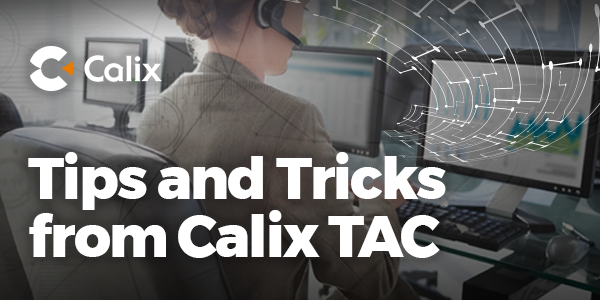Top TAC Hacks You Should Know About

The Calix Technical Assistance Center (TAC) handles several hundred support interactions on a weekly basis helping customers fix problems and gain insight on ways to improve network performance. The TAC team provides software and hardware support and technical expertise to over 1000 Calix customers helping them manage multiservice networks that are large, small, and everything in between. So, we can honestly say they've seen it all. I asked two of our TAC network engineering experts, Mike Carter and Eric Kwedar, to let us in on the top recommendations they routinely share with customers to help them better manage their networks and achieve improved network performance.
1. Upgrade to the latest software on all platforms
When it comes to access and premise software, the phrase “if it ain’t broke, don’t fix it,” is not the right strategy to take. Software updates provide enhancements such as critical network protection and performance fixes. They’re not only important for fixing previous issues, but they also bring new features and functionality for revenue enhancing opportunities. Prior to upgrading though, we highly recommend you review the release notes to become aware of any documented issues or special steps to complete the upgrade successfully. If you need assistance, you can engage Calix Professional Services to help you prepare for and guide you through the upgrade process. Also, the Calix Vantage Support tier includes a software update planning and guidance feature to help service providers optimize network performance with the latest software.
2. Have a network diagram
Records are critical not only for maintaining networks but also for managing growth and making expansions easier when they are needed. When planning a network, it's important to gather requirements like growth, redundancy, and services you want to deliver to your subscribers. Once you have identified and incorporated those, the logical network diagram you develop will provide the blueprint that touches every other stage of the implementation process. And after that, it also provides a good record to refer back to for troubleshooting and planning future projects.
3. Periodically review your network topology and move away from older architectures where possible
We often see customer networks start out with a small set of switches and possibly one router. Frequently, these are configured with older redundancy protocols, such as RSTP, and never migrate to more robust protocols like Ethernet Ring Protection Switching (ERPS) or G.8032. As the network grows, many customers don’t update their network architecture and maintain a flat layer 2 network which can be problematic. A flat layer 2 network has inherent problems such as large broadcast domains, high potential for loops, large convergence times for RSTP, and a large load on upstream routers. Calix suggests as your network grows to review your architecture periodically and plan for improvements, such as adding layer 3 routers to split up your layer 2 access network and migrate to more robust protocols. Our Professional Services team also can assess your network and help you build and implement a plan to update your architecture to the latest best practices to get better performance and scalability.
4. Establish a unique set of service VLANs per access node or ring
We recommend that service providers use a unique set of service VLANs per node or small network area, such as a ring. The benefits include smaller broadcast domains in the layer 2 network, and the ability to troubleshoot issues when they arise more easily. And while it may seem obvious, it’s recommended to separate service traffic like voice, video, mobile backhaul, customer transparent LANs, and Ethernet virtual circuits into separate VLANs. This simple change lets you assign the proper priority to delay and dropped-packet-sensitive traffic types, so the delay sensitive traffic doesn’t have to compete with more fault tolerant traffic. It also helps with troubleshooting specific services by making it easier to spot bad traffic since the routes can be identified.
Calix TAC Network Engineers have a combined 400 years of technical experience and are there for our customers 7x24x365. The Calix Support program is designed to help you improve network performance and uptime, and the Vantage and Essential support tiers give customers direct access to TAC experts along with other features like software update guidance, remote monitoring and management and proactive network health services.
Related Articles




